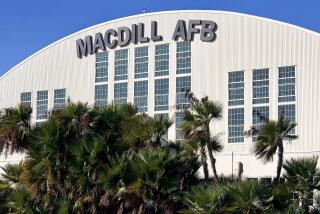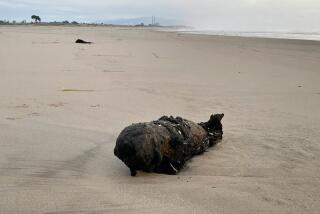Officials Call Runways Safe at Edwards Air Force Base : Antelope Valley: Inspections are stepped up after the discovery of cracks in dry lake bed landing strips.
- Share via
Despite a huge crack that has forced the closure of one runway, officials at Edwards Air Force Base said that most of their famous dry lake bed landing strips remain open and safe for use by space shuttles and jets because of extensive testing and repair efforts.
Although the fissure--a half-mile long, up to 12 feet deep and four feet wide--was described as perhaps the biggest of its kind in the state, air base officials expressed confidence Thursday that pilots landing on Rogers Dry Lake Bed need not worry about hitting other cracks or holes.
“My feeling is there’s adequate measures to ensure that wouldn’t be a problem at this time,” said Larry Plews, the civilian Air Force engineer who oversees work on the 44-square-mile lake bed.
“That’s my thinking now, but it may change,” he warned.
The Air Force and NASA in recent years have used airborne infrared photography, ground penetrating radar, a hydraulic pressure testing device, and even a load cart designed to simulate the weight of a space shuttle’s landing gear to check the stability of the base’s clay runways, Plews said.
Base officials and federal geologists believe the huge fissure and smaller problems with sinking and cracking of the lake bed ground in recent years are the result of ground-water pumping, which causes the soil above shrinking underground aquifers to settle.
Edwards officials worry the lake bed problems could get worse, particularly if the state’s drought, now in its fifth year, forces Antelope Valley water agencies to substantially increase ground-water pumping. But for now, they said, all the base’s open runways are considered safe.
Plews said base and NASA officials have been very cautious ever since the in-flight explosion of the space shuttle Challenger in January, 1986, and an episode several years ago when the landing gear of another shuttle began to sink into an Edwards lake bed runway as the craft was being towed after landing.
Because of the huge crack found about two weeks ago, Plews said the base probably will expand airborne photography of the lake bed in an attempt to find any other weakened areas. Also, Plews said the U.S. Geological Survey will probably become more involved in the lake bed investigation.
A Geological Survey official described the fissure as apparently the largest of its kind in California.
Even before discovery of the huge crack, the Air Force had assigned a full-time crew of five to seven people to fill in smaller potholes and cracks found on the clay runways. Base officials said rainfall seemed to aggravate the problems.
Rogers Dry Lake is the key to the base’s status as the country’s premier flight test facility. The lake bed’s many long, wide, clay runways provide an extra margin of safety to landings of special aircraft. Virtually all new military jets are tested at the base, situated about 90 miles northeast of Los Angeles.
The large crack, found after recent rains at the base, closed the base’s four-mile-long runway 7/25 for at least a month. Another clay strip, the two-mile-long runway 9/27, also is closed for at least several weeks because of soil damage caused by rain. Both are secondary runways.
Air Force officials said cracking problems on the lake bed have been getting gradually worse, and are part of an overall deterioration that they say is also caused by the drought. In the past, rainfall and desert winds had helped smooth the lake bed’s clay surface.
As a result, a third clay runway that was once a common landing site for space shuttle missions has been ruled off-limits to them for the past year, base officials said. Crumbling soil at one end of runway 17/35, the base’s longest at 7.5 miles, made it too dangerous for the shuttles.
More to Read
Sign up for Essential California
The most important California stories and recommendations in your inbox every morning.
You may occasionally receive promotional content from the Los Angeles Times.













